Click here for Part II and here for Part I
Why in news?
The Union Minister for Finance and Corporate Affairs, Ms. Nirmala Sitharaman tabled the Economic Survey 2018-19 in the Parliament.
What are the key highlights?
EXTERNAL SECTOR
- World Trade - As per WTO, World trade growth has slowed down to 3% in 2018, much below the growth rate of 4.6% in 2017.
- This was mainly because of -
- the introduction of new and retaliatory tariff measures
- heightened US-China trade tensions
- weaker global economic growth
- volatility in financial markets
- India’s balance of payment situation witnessed some signs of deterioration during H1 of 2018-19.
- This was due to the sharp rise in crude oil prices, causing higher current account deficit (CAD), in turn, due to higher trade deficit.
- However, CAD moderated somewhat in Q3-2018-19 as international crude oil prices eased sequentially towards the end of 2018.
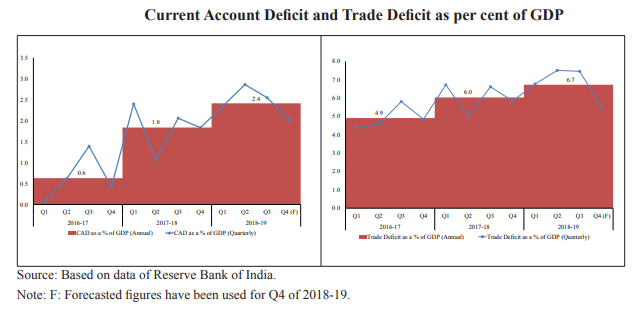
- Trade - The growth rate of merchandise exports and imports fell in 2018-19 compared to previous year.
- This was attributable to the slower growth of world output and trade, along with lower domestic GDP growth in 2018-19, among other factors.
- The contribution of net services to financing merchandize trade deficit has fallen from around 62% in 2016-17 to around 43% in 2018-19.
- This reflects a weak performance of service exports in recent times.
- Notably, during first half of 2017-18, the Net surplus in the services had financed about 49% of India’s merchandise deficit.
- Capital flows - Net capital flows moderated in April-December of 2018-19.
- This was despite robust foreign direct investment (FDI) inflows as it was outweighed by withdrawals under portfolio investment.
- Remittances - India remained a top remittance recipient country in 2018.
- The net remittances by Indians employed overseas increased in 2018-19 (P-Provisional) compared to last year.
- This is possibly due to improved income conditions in the Gulf countries, along with rise in oil prices.
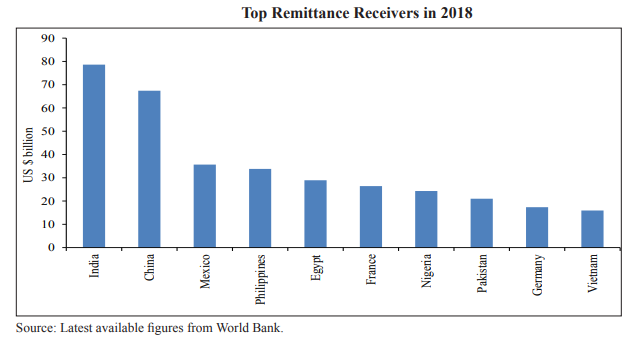
- Foreign Exchange - Among the major economies running current account deficit, India is the largest foreign exchange reserve holder.
- India is also the 8th largest among all countries of the world in this regard.
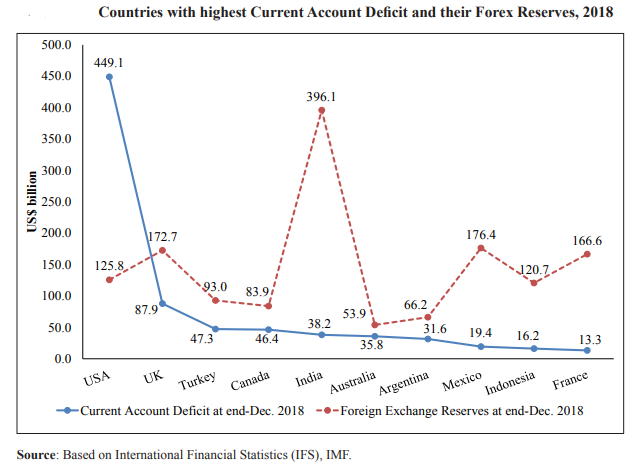
- India’s External Debt was US$521.1 billion at end-December 2018, 1.6% lower than its level at end-March 2018.
- The key external debt indicators reflect that India’s external debt is sustainable.
- Total liabilities-to-GDP ratio, inclusive of both debt and non-debt components, has declined from 43% in 2015 to about 38% at end of 2018.
- The share of foreign direct investment has risen and that of net portfolio investment has fallen in total liabilities.
- This reflects a transition to more stable sources of funding the current account deficit.
- Indian Rupee traded in the range of 65-68 per US$ in 2017-18 but depreciated to a range of 70-74 in 2018-19.
- During H1 of 2018-19, rupee remained weak due to concerns related to -
- widening of CAD owing to rising crude oil prices
- tightening of financial conditions caused by increase in Federal Funds rate by the US Federal Reserve
- Import - The income terms of trade is a metric that measures the purchasing power to import.
- This has been on a rising trend, possibly because the growth of crude prices has still not exceeded the growth of India’s export prices.
- Exchange rate in 2018-19 has been more volatile than in the previous year.
- This was mainly due to volatility in crude prices, but not much due to net portfolio flows.
- Trade composition - Composition of India’s exports and import basket in 2018-19 (P):
- Exports (including re-exports) - around Rs. 23, 07,000 Cr
- Imports - around Rs. 35, 94,000 Cr
- The composition of India’s exports and import basket has almost remained unchanged in 2018-19 over 2017-18.
- Petroleum products, precious stones, drug formulations, gold and other precious metals continue to be top export items.
- Crude petroleum, pearl, precious, semi-precious stones and gold remain as top import items.
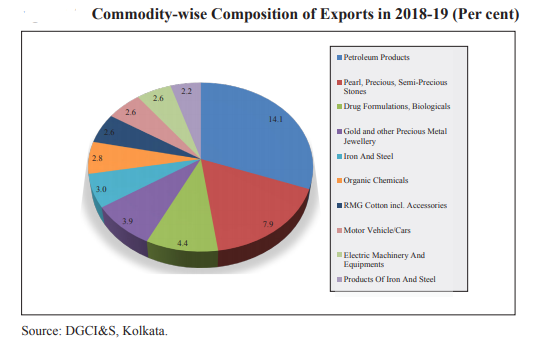
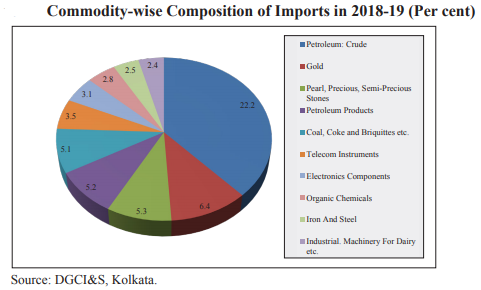
- Trading Partners - India’s main trading partners continue to be the US, China, Hong Kong, the UAE and Saudi Arabia.
- India has signed 28 bilateral/multilateral trade agreements with various country/group of countries.
- In 2018-19, India’s exports to countries with which it has a trade agreement stood at US$121.7 billion.
- This accounts for close to 37% of India’s exports to all the countries.
- Similarly, in the same year, India’s imports from countries with which it has a trade agreement stood at US$266.9 billion.
- This accounts for 52% of India’s imports from all the countries.
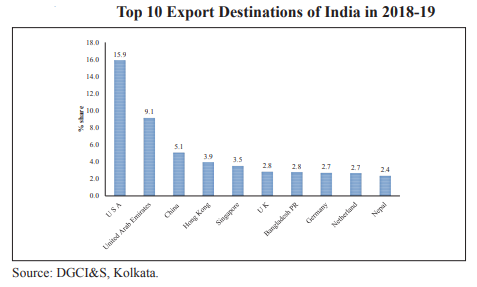
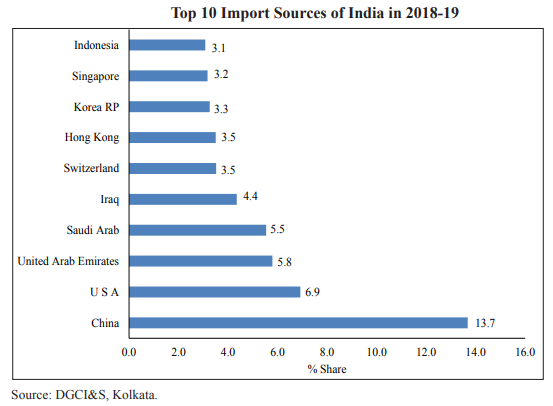
- Logistics industry of India is currently estimated to be around US$215 billion.
- There have been significant developments in this industry.
- This has led to an increase in India's rank in World Bank's 2016 Logistics Performance Index.
- In 2018, India stood at 44th rank.
AGRICULTURE AND FOOD MANAGEMENT
- Contribution - The contribution of Agriculture’s Gross Value Added (GVA) to overall GVA has been declining (14.4% in 2018-19).
- Gross Value Added (GVA) in agriculture improved from a negative 0.2% in 2014-15 to 6.3% in 2016-17.
- But it again decelerated to 2.9% in 2018-19.
- However, agriculture is still a crucial sector, as a large proportion of the population engage in agriculture.
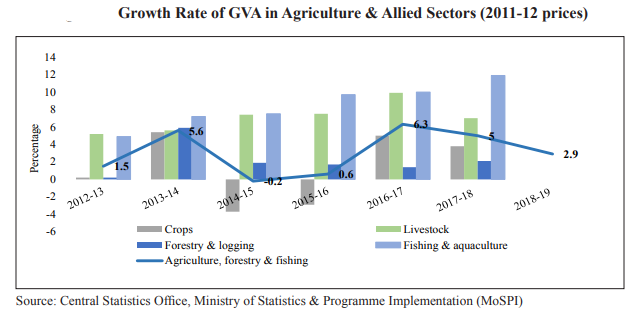
- Gross Capital Formation (GCF) in agriculture as percentage of GVA declined to 15.2% in 2017-18, as compared to 15.6% in 2016-17.
- The public sector GCF in agriculture as a percentage of GVA increased to 2.7% in 2016-17 from 2.1% in 2013-14.
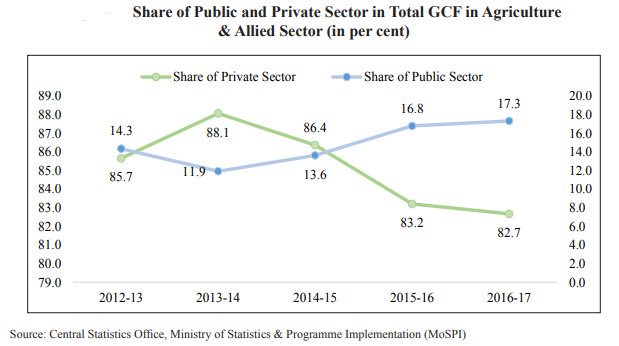
- Women’s participation in agriculture has increased to 13.9% in 2015-16 from 11.7% in 2005-06.
- Their concentration is now the highest (28%) among small and marginal farmers.
- Land holdings - The number of operational land holdings and area under operation have shifted towards small and marginal farmers.
- Water use - Around 89% of groundwater extracted is used for irrigation.
- Crops such as paddy and sugarcane consume more than 60% of irrigation water.
- The States like Tamil Nadu, Karnataka, Maharashtra and Andhra Pradesh, which have high land productivity, tend to have very low irrigation water productivity.
- So, the focus should shift from land productivity to ‘irrigation water productivity’.
- Therefore devising policies to incentivize farmers to improve water use should become a national priority.
- Thrust should be on micro-irrigation that can improve water use efficiency.

- Fertilizer response ratio has been declining over time.
- In this regard, organic and natural farming techniques including Zero Budget Natural Farming (ZBNF) can improve both water use efficiency and soil fertility.
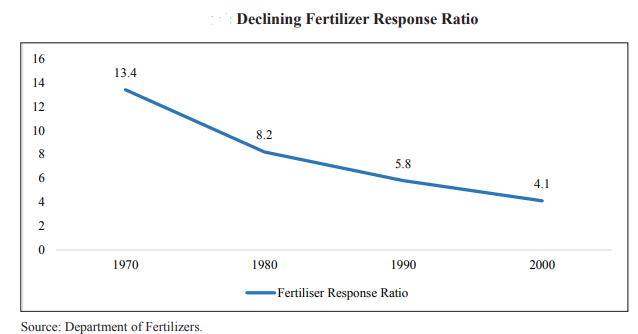
- Technology adoption - Over the years, several new challenges have emerged before the sector including fragmentation of agricultural holdings and depletion of water resources.
- So, adoption of a resource-efficient, ICT based climate-smart agriculture can enhance agricultural productivity and sustainability.
- Adopting appropriate technologies through Custom Hiring Centers and implementation of ICT should be strategized.
- Significantly, small-holder farming can be a profitable livelihood opportunity with the application of appropriate technologies.
- Diversification of livelihoods is critical for inclusive and sustainable development in agriculture and allied sectors.
- Policies should focus on
- dairying (India is the largest producer of milk)
- livestock rearing particularly of small ruminants
- fisheries sector (India is the third largest producer)
- Food security - Agriculture is critical for the country’s food security.
- The rationalisation of food subsidy and greater use of technology in food management will ensure food security for all.
INDUSTRY
- The industrial growth in terms of Index of Industrial Production (IIP) registered 3.6% in 2018-19 as compared to 4.4% growth rate in 2017-18.
- The moderation in IIP growth is mainly due to subdued manufacturing activities in Q3 and Q4 of 2018-19.
- This, in turn, was due to -
- slower credit flow to medium and small industries
- reduced lending by NBFCs owing to liquidity crunch
- tapering of domestic demand for key sectors such as automotive sector, pharmaceuticals, and machinery and equipment
- volatility in international crude oil prices, etc
- Meanwhile, the overall Index of Eight Core Industries registered a growth rate of 4.3% in 2018-19 similar to the increase achieved in 2017-18.
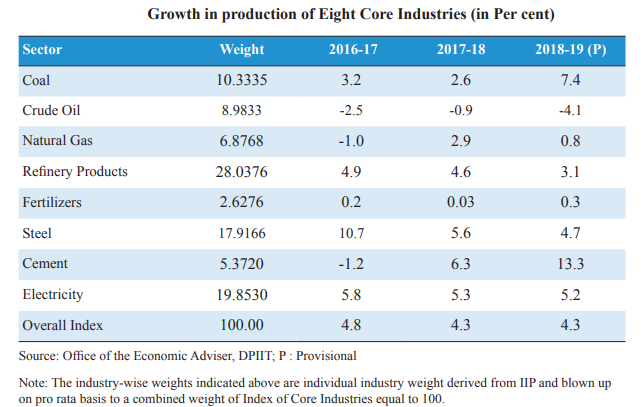
- India has considerably improved its ranking to 77th position (leapt 23 ranks) in 2018 among 190 countries assessed by the World Bank Doing Business (DB) Report, 2019.
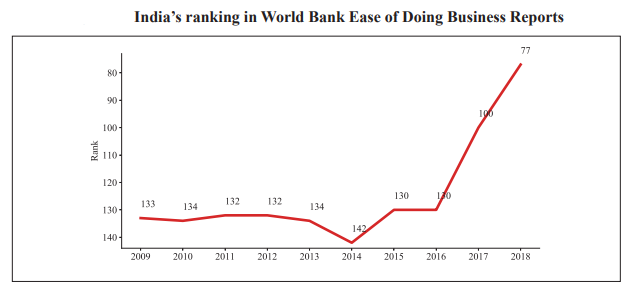
INFRASTRUCTURE
- Building sustainable and resilient infrastructure has been given due importance with the formulation of sector specific programmes such as SAUBHAGYA scheme, PMAY etc.
- Road construction grew at 30 kms per day in 2018-19 as compared to 12 kms per day in 2014-15.
- Rail freight and passenger traffic grew by 5.33% and 0.64% respectively in 2018-19 as compared to 2017-18.
- Total telephone connections in India touched 118.34 crore in 2018-19.
- The installed capacity of electricity has increased from 3,44,002 MW in 2018 to 3,56,100 MW in 2019.
- The challenge ahead is to mobilize adequate investment in infrastructure sector, which runs into several trillions of dollars.
- Public Private Partnerships are essential for addressing infrastructure gaps in the country.
- There is also a need for establishing an institutional mechanism to deal with time-bound resolution of disputes in infrastructure sectors.
SERVICES SECTOR
- Services sector (excluding construction) has a share of 54.3% in India’s GVA.
- It has contributed more than half of GVA growth in 2018-19.
- The services sector growth declined marginally to 7.5% in 2018-19 from 8.1% in 2017-18.
- This was driven by deceleration in the growth of sub sectors such as trade, hotels, transport, communication and broadcasting services.
- However, growth of financial services, real estate and professional services accelerated.
- It is to be noted that India’s services sector does not generate jobs in proportion to its share in GVA.
- Service sector's share in employment is 34% in 2017 which is significantly lesser that its share of 54% in GVA.
- During 2018-19, FDI equity inflows into service sector fell by US$696 million or 1.3% from the previous year to about US$28.26 billion.
- In services, the IT-BPM (business process management) industry grew by 8.4% in 2017-18 to US$167 billion.
- It is estimated to reach US$181 billion in 2018-19.
- Tourism - India received 10.6 million foreign tourists in 2018-19 compared to 10.4 million in 2017-18.
- The foreign exchange earnings from tourism stood at US$27.7 billion in 2018-19 compared to US$28.7 billion in 2017-18.
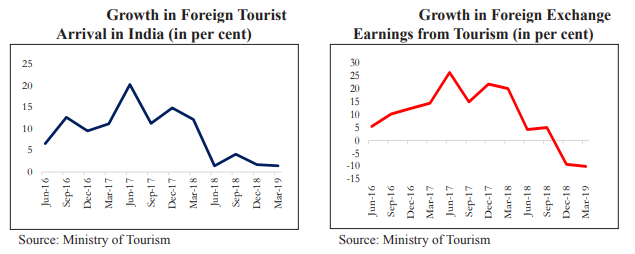
SOCIAL INFRASTRUCTURE, EMPLOYMENT AND HUMAN DEVELOPMENT
- The 17 SDGs (Sustainable Development Goals) and 169 targets envisaged in the Agenda 2030 of the UN, are closely interrelated with social infrastructure.
- The public investments in social infrastructure like education, health, housing and connectivity have a critical role in ensuring inclusive development in a developing country like India.
- Consequently, the improvement in HDI is also interlinked to SDGs as evidenced in the correlation between SDG rankings and HDI rankings of the States.
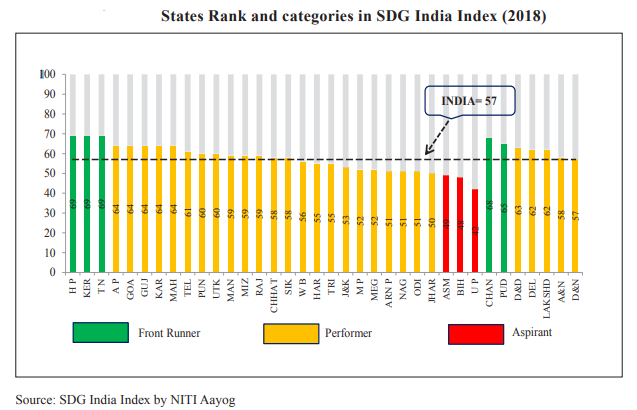
- HDI - India’s HDI (Human Development Index) has improved significantly over the years between 1990 and 2017.
- The country’s HDI value increased from 0.427 to 0.640, but its position is still lowest among its peer countries (Asian and developing economies).
- As per the UNDP Human Development Index (HDI), India is ranked 130 among 189 countries.
- Moreover, India also reflects inter-State disparities in regional and human development, which are reflected by State level HDIs.
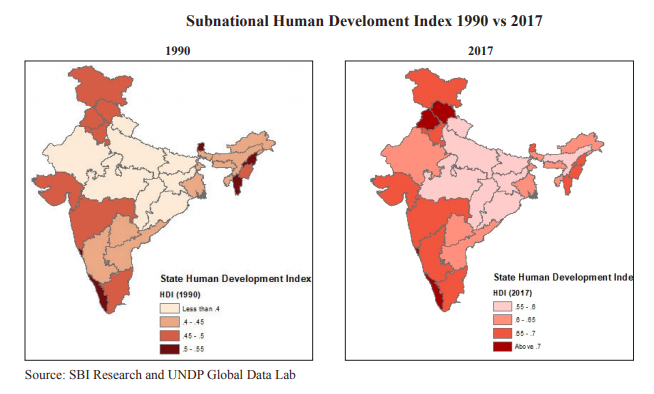
- Education - In India, the percentage of GDP expended on education has remained stagnant at around 3%.
- With the available resources, India has made substantial progress in both quantitative and qualitative indicators of education.
- This is reflected in the improvements in -
- Gross Enrolment Ratios
- Gender Parity Indices
- learning outcomes at primary school levels
- However, the rural urban disparities in access to quality schooling and drop out rates at senior secondary levels remain areas of concern.
- Skilling - The Skilling ecosystem in India is equipping the youth to meet the challenges of a dynamic labour market.
- Short-term and long-term skilling are facilitated under programmes like Pradhan Mantri Kaushal Vikas Yojana (PMKVY).
- PMKVY has had positive impact on employment and incomes of the youth as per evaluation studies.
- The suggestions made in this regard in the Survey include -
- introduction of the skill vouchers as a financing instrument to enable youth obtain training from any accredited training institutes
- involving industry in setting up of training institutes in PPP mode, in curriculum development, in provision of equipment, in training of trainers, etc
- roping in personnel of Railways and para-military for imparting training in difficult terrains
- creating a database of Instructors, skill mapping of rural youth by involving local bodies to assess the demand-supply gaps
- Employment - The PLFS (Periodic Labour Force Surveys) has reported declining LFPR (labour force participation rate) along with increasing unemployment rate.
- Government has prioritized employment programmes like MGNREGS.
- This is reflected in the upward trend in budget allocation and release of funds to the States in the last 4 years.
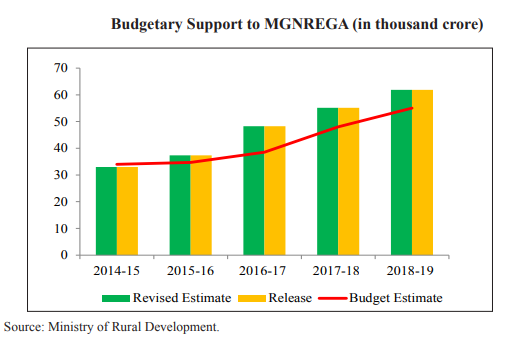
- Health - The expenditure on health has hovered around 1% of GDP during the past few years.
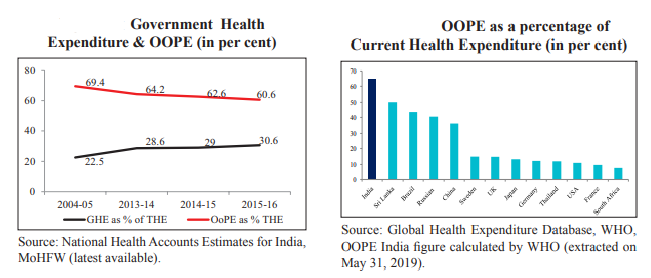
Note: OOPE - Out of Pocket Expenditure; THE - Total Health Expenditure
- Accessible, affordable and quality healthcare are being provided by the Government under the National Health Mission and through new schemes like Ayushman Bharat.
- The select health indicators like MMR, IMR, U5MR have shown tremendous improvement over the past few years.
- Alternative healthcare, National AYUSH Mission, was launched to provide cost effective and equitable AYUSH healthcare.
- Household autonomy of women is the first step towards achieving empowerment and becoming agents of change in patriarchal societies like India.
- In this context, financial inclusion initiatives have improved the household autonomy of women as reflected by the NFHS (national family health survey) data.
- Connectivity is critical for rural areas, to improve quality of lives of the poor by enhancing access to various social services, education, health and access to markets.
- In this regard, PMGSY (Pradhan Mantri Gram Sadak Yojana) has played a crucial role in connecting the unconnected in rural India and enhanced their livelihood opportunities.
- Around 1,90,000 km of rural roads were constructed under PMGSY since 2014.
- Housing - Government has accorded highest priority to rural housing, by providing dwelling with all basic facilities to the most needy under PMAY-G (Pradhan Mantri Awas Yojana - Gramin).
- About 1.54 crore houses were completed under PMAY as against a target of 1 crore pucca houses with basic amenities by 31st March, 2019.
- Way Forward - To reap the benefits of demographic dividend, the government is committed to improve the outcomes in education and skilling, and to provide employment and affordable healthcare to all.
- India's march towards achieving SDGs is firmly anchored in investing in human capital and inclusive growth.
Source: Ministry of Finance Website
